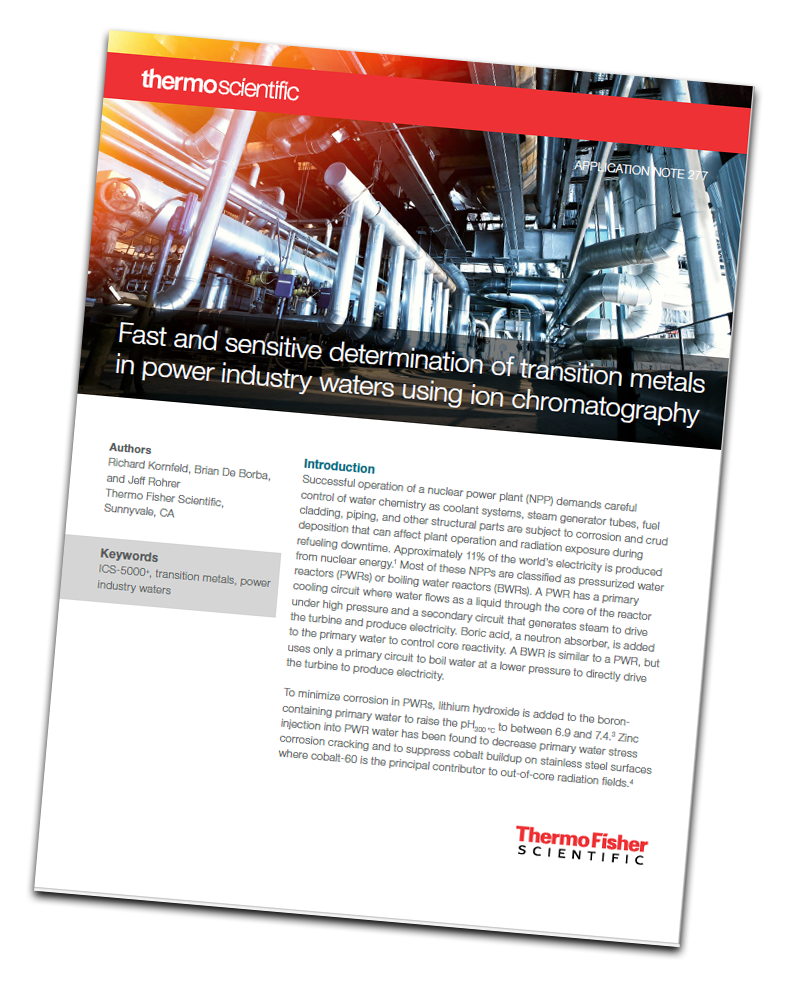This study focused on method performance of ion chromatography (IC) with post column derivatization and absorbance detection for determining iron (III), copper (II), nickel (II), and zinc (II) in surrogate nuclear power plant (NPP) waters.
 Successful operation of a nuclear power plant (NPP) demands careful control of water chemistry as coolant systems, steam generator tubes, fuel cladding, piping, and other structural parts are subject to corrosion and crud deposition that can affect plant operation and radiation exposure during refueling downtime. Approximately 11% of the world’s electricity is produced from nuclear energy. Most of these NPPs are classified as pressurized water reactors (PWRs) or boiling water reactors (BWRs). A PWR has a primary cooling circuit where water flows as a liquid through the core of the reactor under high pressure and a secondary circuit that generates steam to drive the turbine and produce electricity. Boric acid, a neutron absorber, is added to the primary water to control core reactivity. A BWR is similar to a PWR, but uses only a primary circuit to boil water at a lower pressure to directly drive the turbine to produce electricity.
Successful operation of a nuclear power plant (NPP) demands careful control of water chemistry as coolant systems, steam generator tubes, fuel cladding, piping, and other structural parts are subject to corrosion and crud deposition that can affect plant operation and radiation exposure during refueling downtime. Approximately 11% of the world’s electricity is produced from nuclear energy. Most of these NPPs are classified as pressurized water reactors (PWRs) or boiling water reactors (BWRs). A PWR has a primary cooling circuit where water flows as a liquid through the core of the reactor under high pressure and a secondary circuit that generates steam to drive the turbine and produce electricity. Boric acid, a neutron absorber, is added to the primary water to control core reactivity. A BWR is similar to a PWR, but uses only a primary circuit to boil water at a lower pressure to directly drive the turbine to produce electricity.
This study describes the separation of iron (III), copper (II), nickel (II), and zinc (II) complexes with PDCA followed by post-column PAR reaction and absorbance detection at 530 nm. Surrogate samples include spiked deionized (DI) water (BWR surrogate) and spiked borated water containing lithium hydroxide with or without added zinc (PWR surrogates). Detection limits <0.1 μg/L were achieved after concentration of 4.7 mL of sample. The linearity, detection limits, precision, and accuracy of the method for determining the targeted transition metals at sub-μg/L concentrations in surrogate BWR and PWR samples are described.
For experimental and sample preparation conditions, please refer to the full application note.
Results and Discussion
Linearity, limits of detection/quantification
The limit of detection (LOD) and limit of quantification (LOQ) estimates were assessed by measuring peak-to-peak noise in blank injections and converting these noise measurements to estimated analyte concentrations using calibration standards prepared in DI water. The LOD and LOQ were calculated from noise in the system blank using data from a chromatogram generated without injecting the DI water concentrate into the column.
Conclusion
An IC method with 530 nm absorbance detection was evaluated for the determination of iron (III), copper (II), nickel (II), and zinc (II) at sub- and low-μg/L concentrations in boiling water and the primary cooling circuit of pressurized water nuclear power plant reactors. The Dionex IonPac CS5A column with a PDCA eluent allowed the separation of the four target transition metals in less than 10 min., even in the presence of high concentrations of boric acid and lithium that constitute the PWR primary coolant surrogate matrix. Excellent recoveries were achieved for the target analytes in DI water and boric acid/lithium hydroxide matrices, with and without additional zinc added. Method performance was further demonstrated by the fact that no significant differences were observed in the retention time and peak area RSDs for the target analytes in both surrogate samples. The method was not subject to interference from common cations that is typically observed using non-suppressed conductivity detection. Additionally, the method produced sub-μg/L LODs and LOQs and good linearity applicable for the determination of the four target transition metals in nuclear power industry waters.




